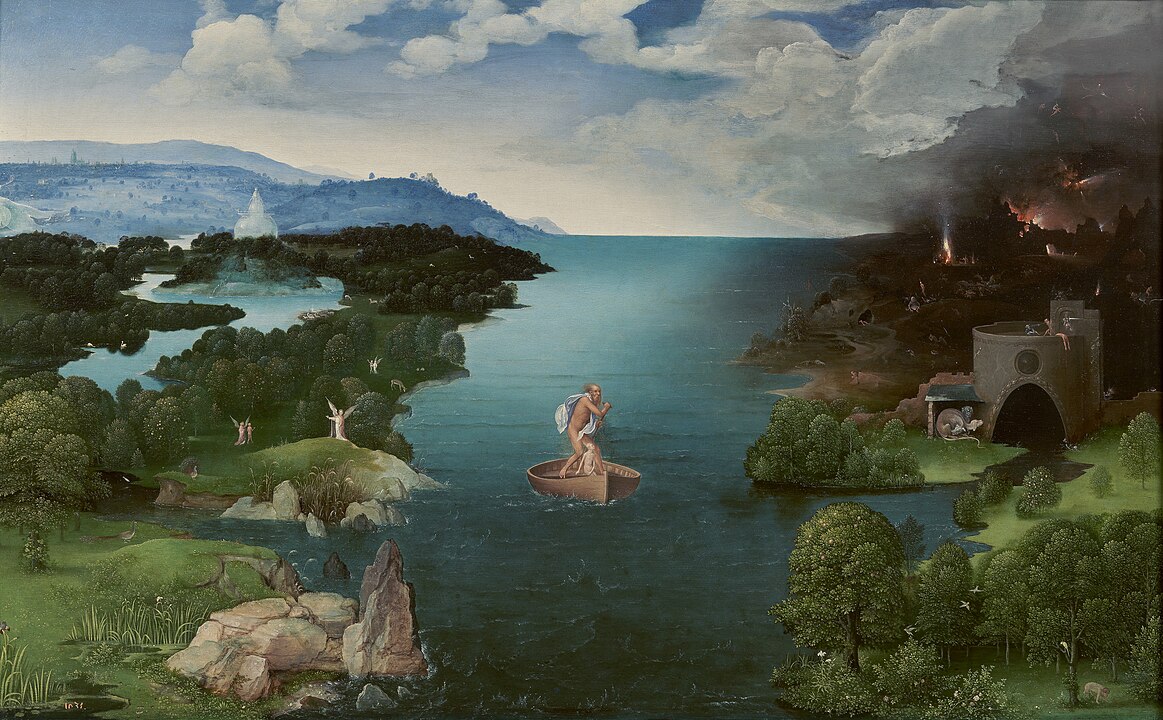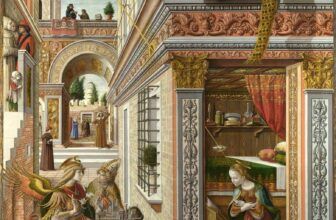
Joachim Patinir’s Journey Through Judgment and the Human Soul
Few works of art capture the chilling drama of the human soul at the brink of eternal judgment quite like Joachim Patinir’s “Landscape with Charon Crossing the Styx.” Painted in the early 16th century during the Northern Renaissance, this striking and allegorical piece is a masterpiece of landscape painting, rich in symbolism, theological commentary, and psychological depth. Through its complex interplay of mythological imagery and religious morality, Patinir invites viewers into a breathtaking yet terrifying vision of the afterlife.
Who Was Joachim Patinir?
Joachim Patinir (c. 1480 – 1524) was a Flemish painter who is widely recognized as a pioneer of landscape painting in Western art. Born in Dinant in present-day Belgium, Patinir spent much of his career in Antwerp, then a flourishing center of commerce and culture in the Netherlands. A contemporary and friend of Albrecht Dürer, who allegedly referred to him as a “good painter of landscapes”, Patinir’s innovation lay in shifting the traditional focus of religious painting away from central human figures and placing it instead on vast, meticulously detailed landscapes.
In this, Patinir can be said to have transformed the background into the protagonist. His works often feature dramatic topography, exaggerated horizons, and allegorical elements that imbue the land itself with narrative meaning. “Landscape with Charon Crossing the Styx,” painted circa 1515–1524, is perhaps his most famous and profound work.
How “Landscape with Charon Crossing the Styx” Was Painted
This painting was created using oil on wood panel, a popular medium among Northern Renaissance painters. Oil paints offered Patinir the flexibility to layer colors and build up the kind of luminous, atmospheric effects that bring his landscapes to life. The panel format allowed for fine detail and preservation over time.
The painting showcases Patinir’s hallmark “world landscape” style, a sweeping, bird’s-eye view that combines multiple geographic features: winding rivers, jagged cliffs, verdant forests, and an expansive sky. Unlike many Italian Renaissance painters who emphasized linear perspective and symmetrical compositions, Patinir’s landscapes are panoramic and psychologically charged. He constructs the world not as it is but as a stage for spiritual drama.
Interestingly, Patinir often collaborated with other painters. It is believed that the figure of Charon and other human forms were painted by another artist, possibly Quentin Matsys, who was known for his talent in rendering figures. This division of labor was typical in Antwerp workshops of the time.
What Is Happening in Landscape with Charon Crossing the Styx?
“Landscape with Charon Crossing the Styx” presents a narrative inspired by Greek mythology and Christian eschatology, harmonizing classical and religious traditions into one cohesive moral tale.
At the center of the painting is the mythical ferryman Charon, transporting a naked human soul across the river Styx, the boundary between the world of the living and the dead in ancient mythology. The small boat he pilots carries the soul, who appears uncertain and fearful as they approach the place of judgment. Charon, with a gaunt and menacing expression, grips his oar and steers the craft forward.
The soul in the boat faces a fateful choice, as the river splits into two distinct paths:
To the left, a foreboding, fiery red land suggests Hell. Demonic creatures wait along the rocky shoreline. The sky burns with hues of sulfurous red, and a sense of doom pervades.
To the right, a tranquil, verdant landscape beckons. This is Heaven or Paradise, represented with pastoral beauty, clear skies, and peaceful architecture.
This pivotal moment dramatizes the instant of judgment after death, where the soul must reckon with the choices made in life and face the consequences, eternal bliss or eternal damnation.
What the Landscape with Charon Crossing the Styx Represents
At its core, “Landscape with Charon Crossing the Styx” is an allegory of the soul’s journey after death. Patinir combines the classical myth of Charon with Christian theology concerning Heaven and Hell, creating a fusion that is uniquely Renaissance in its intellectual scope and spiritual gravity.
The soul’s position in the boat, in the moment before a decision is made, encapsulates the anxiety of salvation and the moral weight of free will. Unlike deterministic interpretations of fate, this painting implies that human beings have agency: the landscape is a visual manifestation of moral choice.
The river Styx, then, is not merely a border between life and death, but a psychological and spiritual threshold. The decision of which shore the soul will ultimately reach lies suspended in dramatic tension.
Symbolism and Meaning
This painting is replete with symbolism that deepens its theological and moral resonance.
1. Charon – The Ferryman
In classical mythology, Charon is the one who ferries souls across the rivers of the underworld. Patinir’s depiction of Charon as a skeletal, grim figure echoes medieval representations of Death, suggesting his neutrality but also his inevitability.
2. The River Styx
The river serves as a metaphysical boundary, not just between life and death, but between good and evil, salvation and damnation. It is also a mirror of the soul, calm in some places, turbulent in others, reflecting the inner turmoil of moral reckoning.
3. The Soul in the Boat
The soul appears lost, possibly unaware of its fate. It is completely naked, indicating purity, or perhaps vulnerability and judgment. This bareness before judgment reflects Christian ideas of divine omniscience, where no sin can be hidden.
4. Heaven vs. Hell
The contrast between the two shores is extreme:
Hell, on the left, is a landscape of decay: burning skies, monsters, blackened trees, and jagged rocks. It may echo Hieronymus Bosch’s hellscapes in its grotesque imaginings.
Heaven, on the right, is serene and orderly. The architecture of the buildings suggests stability, reason, and divine perfection. Light suffuses this part of the landscape, highlighting the salvation that lies in righteous living.
5. Colors and Composition
Patinir uses color symbolically:
Reds and blacks dominate the Hell side, invoking fear and violence.
Greens and blues dominate Heaven, invoking peace, purity, and divine grace.
He also uses aerial perspective to enhance spatial depth, making the painting both an aesthetic experience and a theological meditation.
What Type of Art Is Landscape with Charon Crossing the Styx?
“Landscape with Charon Crossing the Styx” is a prime example of Northern Renaissance art, specifically within the genre of religious landscape painting. But it is more than a religious painting, it is a philosophical exploration, a psychological study, and a moral compass.
Technically, it belongs to:
Northern Renaissance painting
Oil on panel
World landscape genre
Allegorical and mythological-religious fusion
Patinir is often credited as one of the first true landscape specialists, and this painting demonstrates the potential of landscape to carry moral and spiritual significance far beyond its physical forms.
How Much Is the Painting Worth?
“Landscape with Charon Crossing the Styx” is considered a priceless cultural treasure and is not for sale. As with many works from the 16th century, it resides in a public collection and is considered irreplaceable.
If hypothetically assessed on the open market, assuming legal and ethical sale, which is extremely unlikely, the painting could be valued in the tens to hundreds of millions of dollars, considering its historical importance, rarity, and contribution to Western art history. However, such speculation is purely theoretical, as works of this stature are never sold privately.
Where Is the Painting Located Today?
Today, “Landscape with Charon Crossing the Styx” is housed in the Museo del Prado in Madrid, Spain. The Prado Museum holds one of the most important collections of European art in the world, and Patinir’s painting is considered a gem among its holdings.
The museum provides the perfect setting for viewing the work in context, as it also displays other Northern Renaissance masters and Spanish religious art, allowing visitors to appreciate the thematic and stylistic crosscurrents that define this era.
Joachim Patinir’s “Landscape with Charon Crossing the Styx” is more than a painting, it is a philosophical mirror, a theological map, and a psychological exploration of the afterlife. With every detail, Patinir asks the viewer to consider their own soul’s destiny: What choices define us? What path awaits us beyond the veil of death?
Through a masterful blend of myth and Christian doctrine, symbolic landscape and narrative power, Patinir created a visual sermon for the eyes and the soul. In doing so, he laid the groundwork for future landscape painters and set a precedent for using nature not just as scenery, but as a vehicle for spiritual and existential storytelling.
Whether viewed as a work of beauty, a meditation on mortality, or a moral guidepost, “Landscape with Charon Crossing the Styx” continues to speak across the centuries, reminding us that art, like the soul, often stands at the crossroads of light and darkness, choice and fate.




